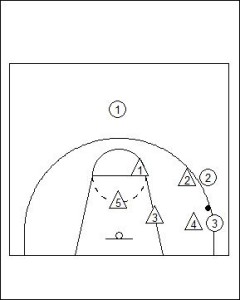3-2 Sliding Zone Defence
The 3-2 Sliding Zone Defence is a match-up zone defence that looks to create mismatches between interior and perimeter players. The 3-2 Sliding Zone Defence places a number of players around the basket and limits the distance that players have to move while still engaging the player with the ball and those offensive players one pass away.
The core tactic which makes the 3-2 Sliding Zone Defence different is the rotation of the top player through the middle of the zone defences help positions. In the diagrams below, the Three (3) rotates along the strong side of the keyway covering specific offensive positions of importance. The Small Forward or Finesse Forward is a good selection for this position, as this player’s attributes is usually a combination of speed, agility, and size. For this reason the Three (3) has the speed to match-up with perimeter players at the top of the 3-2 formation and then match the size and agility needed to spoil the offensive play of post players either in the high or low post.
Because of the match-up tactical element within the 3-2 Sliding Zone Defence, a feature of the defensive rotations is to isolate the ball when passed into the long corner. When either the ball is passed through hands or otherwise the 3-2 Sliding Zone Defence attempts to clamp the ball into this area of the floor and limit the possible offensive targets except through long and slow skip passes away from the basket.
Another aspect of the 3-2 Sliding Zone Defence that is of significance is it leaves the Centre close to the basket at all times. Often a weakness of too many zone defences is their problem keeping the teams often best shot blocker and strongest rebounder close to the basket. As an added the benefit the Centre plays help defence if the ball is attempted to be lobbed into post targets. This would again place the Five (5) between the basket and the offensive player.

The 3-2 Sliding Zone Defence set-up is the same as any other 3-2 Zone Defence. This is an important aspect, as teams will not anticipate the variation to the standard rotation.
It is important the top player in the 3-2 Sliding Zone Defence is a tall or very long player so they are able to withstand the different demands of the ‘slider’ position.
The Three (3) stops the penetration initially into the key. Upon the pass to the wing Two (2) moves to guard the ball as with a conventional 3-2- Zone Defence. The Three (3) however moves to the strong side high post.
Weak side players One (1) and Five (5) shift to the split line and into strong help positions.

On the pass from the wing position to the long corner Four (4) closes-out to the ball.
Upon this rotation two other players also move. Three (3) shifts into the strong side low post. If there is an offensive player in the low post Five (5) will engage and defend this player until Three (3) can rotate into this position.
The defensive option when guarding the post can include three (3) fronting the post or halving the post. With Five (5) in a help position the likelihood of successful lob should be very low so fronting is a very viable option.
One (1) rotates into the strong side high post position.
Two (2) continues to hold their position and denies the reversal of the ball back from the long corner.
One (1) should look to gamble on the long and slow skip pass from the long corner and attempt to deflect or steal the ball if possible.

With the ball in the long corner the 3-2 Sliding Zone Defence is set and tries to maintain pressure by keeping the ball in this position.
As with all zone defences the more the ball is moved and offensive players re-position themselves the weaknesses of the zone defence will be exposed.
For this reason, players such as Two (2) and Three (3) are in full denial so the ball cannot be easily rotated through hands forcing the majority of the defensive players to also rotate.
If there is no low post target then Five (5) can lift slightly higher along the split line and fill space back towards the middle of the floor.
Related articles







